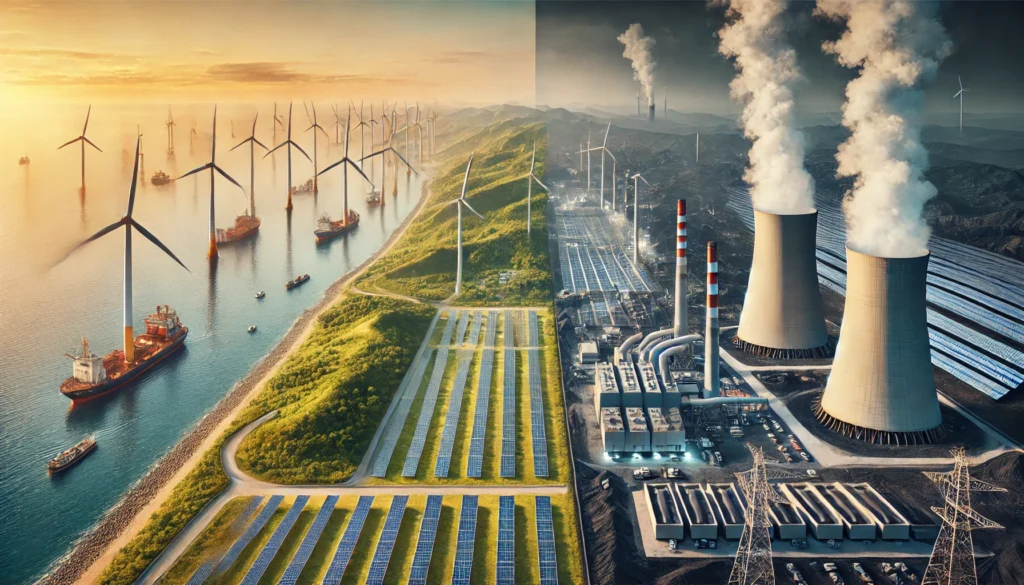Despite leading the world in renewable energy investments, China’s continued reliance on coal raises questions about its climate commitments—will the green revolution outpace the fossil fuel grip?
The National Development and Reform Commission (NDRC) of China announced investments in renewable energy projects of national significance this week—another leap towards its green energy transition. The initiative combines offshore wind farms with large clean energy bases for solar and wind generation. Meanwhile, China still emits the most greenhouse gases worldwide, with continued reliance on coal being the central point of contention against its climate commitments.
China’s Green Energy Leadership
The country’s position regarding climate change has always been to balance between being a global leader in renewable energy and being the number one cause of carbon dioxide emissions. Joanna Lewis, Professor of Practice and Director of the Science, Technology, and International Affairs Program at Georgetown University, points out China’s roadmap:
“Several clean energy industries were identified decades ago as strategic industries, and the government has invested heavily to become a global leader. This has been a long-term effort to promote domestic renewable energy deployment while also expanding China’s industrial capacity in green technologies.”
Climate Targets: Ambitious with Uncertainty Attached
In 2020, China declared that carbon emissions were to peak by 2030 and carbon neutrality was to be achieved by 2060. Since then, major steps have been taken in the direction of renewable energy technology and its uptake. Most notable among these are:
- In 2024, China accounted for two-thirds of the $2.1 trillion global energy transition investment, according to BloombergNEF.
- The country generates 31% of its electricity from renewable sources, including wind, solar, hydro, and geothermal energy.
- Solar energy is expected to surpass coal as the number one source of energy in China by 2026.
Another important shift will be seen with the BRI acting towards green energy and sustainable infrastructure provision of clean energy goods to developing nations. “China’s push to subsidise and nurture green energy industries wasn’t just to serve the domestic market—it was to serve the global market,” said Samantha Gross, director of the energy security and climate initiative at the Brookings Institution.
Chinese renewable energy exports grew by 35% between 2019 and 2023, with the country also dominating the global EV battery market at 60%.
The Coal Dilemma: Expanding Amid the Green Transition
The sustained reliance on coal is yet the critical angle on which the massive investments for green energy in China will hang. Coal-fired power capacity, amounting to 66.7 GW, was approved by China in 2024, the highest in a decade. Coal stands at the centre of energy generation within China, owing to:
- Energy security requirements: Coal ensures some stability in electricity generation amidst rising electricity demand.
- Economically difficult: On a macroeconomic scale, coal is a major economic contributor to a select few provinces in China, impairing a rapid phase-out politically.
Joanna Lewis underlines that:
“There is an inherent conflict. China has ambitious climate targets, but to meet them, growth in renewables must not only outpace fossil fuels but also lead to a decline in their role.”
The EU has been calling for the cessation of any additional coal plants by the People’s Republic of China; however, it is still anybody’s guess as to what measure will be taken next by Beijing. Notwithstanding the heavy investment by China into renewables, it still saw a rise of 0.8% in its emissions in 2024, making the energy transition rather complicated.
How Does China Stack Up Against Other Nations?
China’s green-energy push has watered global policies such as the U.S. Inflation Reduction Act (IRA), a $400 billion boon for clean energy production. Gross says:
“China has dominated the electric vehicle, battery, and solar panel industries through massive subsidies. The IRA was designed to compete with that.”
But while China has been leading the pack internationally as far as renewable investments go, its NDC under the Paris Agreement says only that emissions would peak by 2030, not what that peak would look like. Many of the EU member states have started a slow-to-onset process of symbolic reductions in emissions—the clearer road to decarbonisation.
Outlook for China
Due to China’s position as the largest carbon polluter, its climate doctrines are important to keep the world under the thresholds of 1.5 or 2 degrees Celsius. Scholars suggest that China is equally committed to reducing coal if serious progress is to be made in the area of renewables:
“We’re not seeing enough signs—even with the impressive buildout of renewables—that China is getting on that path quickly enough,” is Lewis’ warning.
How China decides to balance economic growth, energy security, and climate responsibility will determine its status in the global arena facing climate change. The next few years will tell whether the green transition will entirely deter dependency on coal or whether further fossil fuel expansion will, in fact, undermine the very foundation of its environmental choices.
Source: TIME

